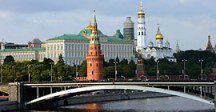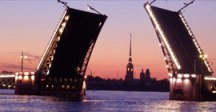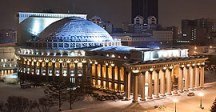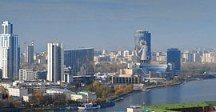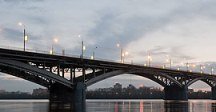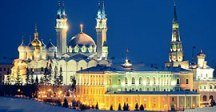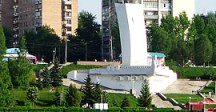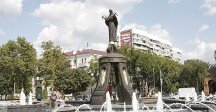Map of Kursk
Detailed interactive map of Kursk. Map of Kursk with streets and numbers of houses. Satellite map of Kursk with sights of the city.
The change between the satellite map of Kursk and the schematic one is made in the lower left corner of the interactive map.
Kursk
Kursk population: 450,977 (2021)
Kursk city phone code: +7 4712
Car code of the city of Kursk: 46
Kursk area: 208 sq.km.
Kursk was founded in 1032.
Postal code of the city of Kursk: 305000
Kursk is a Russian city that was named after the Kur Stream, which flows into the Tuskar River. The city is best known for its developed chemical industry. He wears the Order of the Great Patriotic War, received during the war years of the Second World War for the bravery of the Kursk citizens.
Kursk is most famous as an Orthodox center, because 33 churches are concentrated in this city. The main temple, built in the 17th century, is the Cathedral of the Kazan Mother of God. He is an example of the medieval Baroque style.
What to see in Kursk
The memorial of the Afghan War. As in most cities, Kursk has a memorial to those who died in the Afghan war from December 1979 to February 1989.
Monument to Alexander Nevsky. At one of the entrances to the park named after May 1, there is a monument to Grand Duke Alexander Nevsky of the 13th century, one of the most beloved heroes of Russia. The monument was opened in 2000. It was presented to the city by its sculptor Vyacheslav Klykov, he himself hails from the Kursk region, and is only one of several monuments of the sculptor in the city. It depicts Nevsky with a sword in one hand and a banner in the other.
House of Officers (Planetarium) on Sonina Street. One of the most majestic buildings in Kursk is the House of Officers, which is a red building with beautifully decorated white carved window frames and decorative elements. It was built in 1877, but was severely damaged during the Nazi occupation of Kursk and subsequently rebuilt. Since 1994, the city planetarium, founded in 1956, has been located in the House of Officers.
The monument to the icon of the Mother of God of Kursk Root was opened in 1996 to commemorate the 700th anniversary of the icon's appearance. According to legend, the icon was found in the root of a tree near Kursk. Later, the icon was kept in the city until after the revolution it was taken abroad, where it remains to this day.
The Regional Museum of Local Lore of the Kursk region on Lunacharsky Street. The building, which was once the bishop's chambers, houses the regional Museum of local lore of the Kursk region. It was founded in 1903 and currently has more than 180,000 exhibits. The museum is mainly devoted to the history of the Kursk lands, starting from ancient times up to the Soviet period and modern times.
A statue of Vladimir Lenin stands on Kursk's Red Square in front of the city administration building. The statue of Lenin was erected here in 1933, but it was destroyed during World War II. The current statue was unveiled in 1956 and is the work of the famous sculptor Matvey Manizer.
The Znamensky Monastery was founded in 1612 after the lifting of the Polish siege of Kursk. Initially, the monastery was dedicated to the Nativity of the Most Holy Theotokos, but since 1618 the monastery was again dedicated to the icon of the Sign of the Most Holy Theotokos, since there was an icon of the Most Holy Theotokos of Kursk Root.
The Kursk Art Gallery is named after the artist and sculptor Alexander Deineki, who was born in Kursk in 1899 and is known among other works for his mosaics in the Moscow metro "Mayakovskaya". Previously, the gallery was located in the diocesan Cathedral of St. Sergius of Radonezh and the Kazan Icon of the Mother of God. Today, the gallery presents works from both Western Europe and Russia, as well as ancient icons.
The monument to Alexander Pushkin, the most famous poet of Russia, was opened in 2000 as part of the celebration of the poet's bicentennial and stands outside the Kursk Drama Theater named after Alexander Pushkin. The theater building was built in 1983, and on top of it there is a statue of Niki, the Greek goddess of victory.
The Church of the Ascension of the Lord. In the area historically known as Kazachya Sloboda, there is a beautiful Ascension Church. It was built in the classical style between 1887 and 1888. The main part of the church has five domes standing on octagonal tolobates.
The Catholic Church of Kursk, dedicated to the Assumption of the Blessed Virgin Mary, was built between 1892 and 1896 at the expense of the relatively small Catholic community of the city, which applied for permission to build a church from the middle of the 19th century. The famous artist Kazimir Malevich was married in this church, as he lived in Kursk at that time.
Monument to the apple of Kursk Antonovka on Lenin Street. This unusual monument is dedicated to the Kurskaya Antonovka apple variety and consists of a two-meter apple weighing 150 kilograms and a diameter of one and a half meters. Kursk Antonovka is a popular variety of apples in Russia, which was first grown in the Kursk province in the 19th century.
The Kursk Regional Archaeological Museum was founded in 1991. The museum was originally located in Trinity Church until 1993. He moved to his current location in a building known as the Chambers of Boyar Romodanovsky. There is a legend that Stepan Razin was imprisoned here in 1671, but experts believe that the house dates back no earlier than the middle of the 18th century. The museum's exhibits include samples of tools, jewelry and jewelry coins found during archaeological excavations.
The Church of the Holy Prophet Elijah and the Resurrection on Lenin Street. This church was completed in 1768, replacing an earlier wooden version. In shape, it is a standard octagon design on a cube with one large dome.
The Diocesan Cathedral of St. Sergius of Radonezh and the Kazan Icon of the Mother of God on Gorky Street. One of the most beautiful buildings in Kursk is the diocesan Cathedral of St. Sergius of Radonezh and the Kazan Icon of the Mother of God. It was built between 1752 and 1778 and is a fine example of Elizabethan Baroque. In 1833, Kursk became the main city of his diocese, and this cathedral became the diocesan cathedral.
Trinity Church on Gaidar Street. The Trinity Monastery, founded by order of Boris Godunov in 1597, once stood where the Trinity Church now stands. The church itself dates back to 1742 and is a two-storey building in the shape of an octagon in a cube with an attached bell tower.
The Trinity Convent on Gorky Street was first mentioned in 1631, but most of its buildings were rebuilt in the 19th century. The only cathedral of the monastery is the two-storey Trinity Cathedral, built in 1695, but since then has been reconstructed several times.
The memorial complex for the fallen in the Great Patriotic War was opened in 1984 next to the Nikitsky Cemetery. The complex serves as a military cemetery for soldiers who died during World War II, many of whom are unknown and buried in mass graves.
The Church of St. Nikita, which is also dedicated to the Assumption of the Blessed Virgin Mary, was built in 1846 in the Russian-Byzantine style by the famous architect Konstantin Ton. It was built on the site of an old wooden church in the now-urban Nikitsky cemetery.
Victory Memorial Complex. On the boulevard between Pobedy Avenue and Karl Marx Street, there is a memorial complex dedicated to the victory in the Battle of Kursk Bulge. It was opened in 1998 to commemorate the 55th anniversary of the battle. The complex includes military equipment of that era, eternal flame and the grave of the unknown soldier.
Transport in Kursk
Kursk railway Station is located relatively far from the center. From the station you can get to the city center by buses No. 6, No. 92 or No. 94, or by tram No. 2. Station address: 1 Vokzalnaya Square.
Popular destinations: St. Petersburg, Moscow, Orel, Belgorod, Kaliningrad, Sochi, Adler, Voronezh, Bryansk, Smolensk, Kislovodsk, Perm, Simferopol, Kharkov, Minsk and Donetsk. Commuter trains run in the direction of Belgorod, Orel, Kastornaya and Lgov.
Kursk bus station is located far from the city center. From the railway station you can get there by tram No. 2. The address of the bus station: 114, 50-Letiya Oktyabrya str. Popular destinations of the Kursk bus station: Belgorod, Orel, Stary Oskol, Voronezh.
The Northern bus station of Kursk is located much closer to the center, next to the War Memorial Complex. It is used mainly for suburban nearby dachas and villages. Bus station address: 59 Karl Marx Street. Popular destinations: Belgorod, Orel, Stary Oskol, Voronezh.
Kursk Vostochny Airport is located to the east of the city, about 7 km from the city center. Minibus No. 278 and buses No. 89 and No. 41 run to the airport along Lenin Street and Oktyabrskaya Street.
Kursk is located on the railway between Moscow and Ukraine, and therefore there are many trains connecting Moscow with Kursk. The city also has good transport links to Belgorod and Orel.
On weekends, a special express runs, which departs from Moskovsky Kursky railway Station to Kursk, stopping along the route in Tula, Mtsensk and Orel. 4-5 commuter trains a day usually run between Belgorod and Kursk in both directions. There are 4 buses a day between Belgorod and Kursk, which depart from the Kursk bus station.
Sights of Kursk
Znamensky Cathedral, Merchant Khloponin's House, Church of the Assumption of the Virgin, Monument to Kursk Antonovka, Church of the Holy Royal Passion-Bearers, Church of St. Seraphim of Sarov, Treasurer's House, Building of the Noble Assembly, Church of the Ascension of the Lord, Church of the Resurrection of Christ, Ufimtsev Wind Farm, Church of the Great Martyr Panteleimon, Sergiev-Kazan Cathedral, Kursk Battle Memorial, Art Gallery named after A.A.Deineki, Miracle Island Water Park, Kursk Archaeological Museum, Pushkin Drama Theater, Kursk Circus, Kursk Museum of Local Lore, Boeva Dacha Park, Kursk Regional Literary Museum.
The largest cities in Russia:
2024 © Russia-Karta.ru
